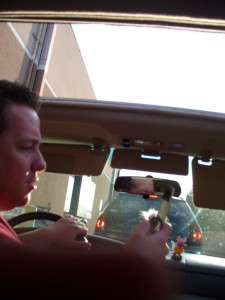Distracted driving has become an epidemic throughout California and across the United Sates. Despite the National Highway Traffic Safety Administration using many publicized campaigns emphasizing anti-texting and anti-distracted driving, accidents and fatalities related to these issues continue to occur. According to distraction.gov:
71% of teens and young people say they have composed/sent SMS messages while driving and 78% of teens and young adults say they have read an SMS message while driving.
While the US Department of Transportation is leading the effort to stop texting and cell phone use behind the wheel, education still remains the top priority to make drivers aware of the dangers involved with distracted driving.
What is Distracted Driving?
Distracted driving is not just limited to cell phone use behind the wheel. Many other activities can divert your attention from the road and lead to a potentially fatal accident. Distraction.gov lists distracted driving as:
Any activity that could divert a person’s attention away from the primary task of driving.
It is important to understand that all distractions endanger driver, passenger, and bystander safety. Some of these distractions include:
- Texting

- Using a cell phone or smartphone
- Eating and drinking
- Talking to passengers
- Grooming
- Reading, including maps
- Using a navigational system
- Watching a video
- Adjusting a radio, CD player, or MP3 player
However, because text messaging requires visual, manual, and cognitive attention from the driver it is perhaps the most dangerous distraction. Imagine the time it takes you to look down to your phone and read or respond to a text message. That length of time while traveling at an increased speed can lead to serious consequences. The United States Department of Transportation states:
Text messaging while driving creates a crash risk 23 times higher than driving while not distracted.
Distractions while driving can be separated into three groups:
- Visual – distractions involve taking your eyes off the road
- Manual – distractions involve taking your hands off the wheel
- Cognitive – distractions occur when your focus is not directly on the act of driving
Distractions created by technology, such as text messaging in particular, can require a combination of all three. This fact is what makes texting while driving especially dangerous.
Preventing Distracted Driving
The best method to prevent distracted driving is through education.
Laws have also been established to help prevent distracted driving incidents.
For example, California has the following laws in place:
- Handheld ban for all drivers (Primary law)
- Ban on all cell phone use (handheld and hands-free) for bus drivers (Primary law)
- Ban on all cell phone use (handheld and hands-free) for novice drivers (Secondary law)
- Ban on texting for all drivers (Primary law)
California defines novice drivers as all drivers under the age of 18.
Preventing distracted driving can be accomplished not only through education, but also through action:
- Don’t make calls or texts while driving, call back or return the text at a safer time. If you feel it is important enough to respond or answer immediately, find a safe place to pull your vehicle over so that you do not put yourself or others at risk.
- If you have young children, teach them the importance of good behavior while in the vehicle, tending to children while driving can be a distraction.
- If possible, designate a passenger in the vehicle to act as “co-pilot” helping with directions or map reading. If this is not possible it is recommended that you pull over to a safe location if you need to read a map or use a GPS device.
- Pre-program favorite radio stations for easy and quick access to help prevent distractions.
- Adjust mirrors, heating or cooling while parked in a safe location.
Distracted driving is a growing problem in the United States.
Unfortunately, it is responsible for many deaths that could likely have been prevented, especially in the younger generation of drivers. To further demonstrate the seriousness of the distracted driving epidemic, it is reported that driving while texting is approximately six times more likely to result in an accident than drinking while driving.
For more information on distracted driving please visit Distraction.gov – Official US Government Website for Distracted Driving.
